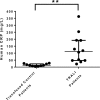Elevation of C-reactive protein levels in patients with transfusion-related acute lung injury
- PMID: 27793007
- PMCID: PMC5363642
- DOI: 10.18632/oncotarget.12872
Elevation of C-reactive protein levels in patients with transfusion-related acute lung injury
Abstract
Transfusion-related acute lung injury (TRALI) is the leading cause of transfusion-related fatalities and is characterized by the onset of acute respiratory distress within six hours following blood transfusion. In most cases, donor antibodies are suggested to be involved, however, the pathogenesis is poorly understood. A two-hit model is generally assumed to underlie TRALI pathogenesis where the first hit consists of a patient predisposing factor such as inflammation and the second hit is due to donor antibodies present in the transfused blood. We recently demonstrated that the acute phase protein C-reactive protein (CRP) could enhance murine anti-major histocompatibility complex (MHC) class I-mediated TRALI. Whether CRP is increased in human TRALI patients which would support its role as a risk factor for human TRALI, is currently unknown. For that purpose, we measured CRP levels in the plasma of human TRALI patients and found CRP levels to be significantly elevated compared to transfused control patients. These data support the notion that CRP may be a novel first hit risk factor in human TRALI and that modulation of CRP levels could be an effective therapeutic strategy for this serious adverse event of transfusion.
Keywords: CRP; TRALI; TRALI first hit; TRALI risk factor; human TRALI.
Conflict of interest statement
There are no potential conflicts of interest.
Figures

Similar articles
-
C-reactive protein enhances murine antibody-mediated transfusion-related acute lung injury.Blood. 2015 Dec 17;126(25):2747-51. doi: 10.1182/blood-2015-09-672592. Epub 2015 Oct 9. Blood. 2015. PMID: 26453659
-
Targeting Transfusion-Related Acute Lung Injury: The Journey From Basic Science to Novel Therapies.Crit Care Med. 2018 May;46(5):e452-e458. doi: 10.1097/CCM.0000000000002989. Crit Care Med. 2018. PMID: 29384784 Review.
-
Transfusion-associated circulatory overload and transfusion-related acute lung injury.Blood. 2019 Apr 25;133(17):1840-1853. doi: 10.1182/blood-2018-10-860809. Epub 2019 Feb 26. Blood. 2019. PMID: 30808638 Review.
-
The Incidence of Transfusion-Related Acute Lung Injury at a Large, Urban Tertiary Medical Center: A Decade's Experience.Anesth Analg. 2018 Aug;127(2):444-449. doi: 10.1213/ANE.0000000000003392. Anesth Analg. 2018. PMID: 29697510
-
The Epidemiology of Transfusion-related Acute Lung Injury Varies According to the Applied Definition of Lung Injury Onset Time.Ann Am Thorac Soc. 2015 Sep;12(9):1328-35. doi: 10.1513/AnnalsATS.201504-246OC. Ann Am Thorac Soc. 2015. PMID: 26102516 Free PMC article.
Cited by
-
Evaluation of Platelet Responses in Transfusion-Related Acute Lung Injury (TRALI).Transfus Med Rev. 2020 Oct;34(4):227-233. doi: 10.1016/j.tmrv.2020.08.002. Epub 2020 Sep 16. Transfus Med Rev. 2020. PMID: 33036839 Free PMC article. Review.
-
The Pathogenic Involvement of Neutrophils in Acute Respiratory Distress Syndrome and Transfusion-Related Acute Lung Injury.Transfus Med Hemother. 2018 Oct;45(5):290-298. doi: 10.1159/000492950. Epub 2018 Sep 21. Transfus Med Hemother. 2018. PMID: 30498407 Free PMC article. Review.
-
The Immune System in Transfusion-Related Acute Lung Injury Prevention and Therapy: Update and Perspective.Front Mol Biosci. 2021 Mar 24;8:639976. doi: 10.3389/fmolb.2021.639976. eCollection 2021. Front Mol Biosci. 2021. PMID: 33842545 Free PMC article. Review.
-
TACO and TRALI: biology, risk factors, and prevention strategies.Hematology Am Soc Hematol Educ Program. 2018 Nov 30;2018(1):585-594. doi: 10.1182/asheducation-2018.1.585. Epub 2018 Dec 14. Hematology Am Soc Hematol Educ Program. 2018. PMID: 30570487 Free PMC article. Review.
-
C-Reactive Protein Enhances IgG-Mediated Cellular Destruction Through IgG-Fc Receptors in vitro.Front Immunol. 2021 Mar 15;12:594773. doi: 10.3389/fimmu.2021.594773. eCollection 2021. Front Immunol. 2021. PMID: 33790888 Free PMC article.
References
-
- Peters AL, Van Stein D, Vlaar AP. Antibody-mediated transfusion-related acute lung injury; from discovery to prevention. Br J Haematol. 2015;170:597–614. - PubMed
-
- Fatalities Reported to FDA Following Blood Collection and Transfusions: Annual Summary for Fiscal Year 2014. Washington, DC: US Department of Health and Human Services, Office of the Assistant Secretary of Health; 2014.
-
- Bux J, Becker F, Seeger W, Kilpatrick D, Chapman J, Waters A. Transfusion-related acute lung injury due to HLA-A2-specific antibodies in recipient and NB1-specific antibodies in donor blood. Br J Haematol. 1996;93:707–713. - PubMed
-
- Middelburg RA, Van Stein D, Briet E, van der Bom JG. The role of donor antibodies in the pathogenesis of transfusion-related acute lung injury: a systematic review. Transfusion. 2008;48:2167–2176. - PubMed
MeSH terms
Substances
LinkOut - more resources
Full Text Sources
Other Literature Sources
Medical
Research Materials
Miscellaneous

